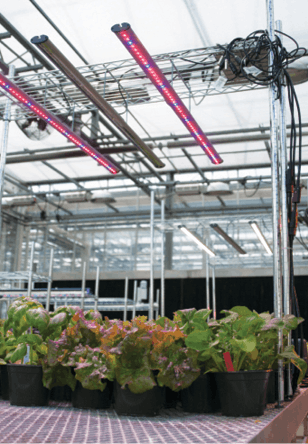
There is no question that light is one of the most important environmental stimuli that impacts both plant growth and development. But, what if certain colors within the light spectrum could alter not only the way that the plant behaves, but the number of desirable traits within the plant? That is exactly the question that plant physiologist Dr. Dean Kopsell, Department Chair at the University of Florida Institute of Food and Agricultural Sciences and formerly of the University of Tennessee, has spent the past five years researching.
Plants are survivors, Kopsell says, adding that when we change their lighting environment—even by simply bringing them indoors—we create stress. But not all stress is bad, in fact. Some stressful environments can help elevate the protective attributes within a plant, like aroma and antioxidants. The key is discovering which stress is beneficial, and which type of stress will have a negative effect.
Initially, Kopsell’s area of study focused on how modifications on the plant environment impacted the development of desirable traits within plants. It was during this research, that he identified that the type of LED lighting and, in particular, the various colors/wavelengths within this lighting, altered the way that a plant developed.
When LEDs first came out, they were low intensity and very expensive, Kopsell says. Today, LEDs can be purchased in a variety of color spectrums and strengths. The challenge is determining which colors and wavelengths will produce the desired response. Kopsell and his team are exploring how different wavelengths impacted both the internal and external structure of the plant.
What the Light Studies Show
Red light is the best color to stimulate plant growth, Kopsell says. However, if plants are grown under only red spectrum lights, they can become thin and leggy. Initially, Kopsell looked at the blue to red light ratio to determine what type of blue light would be best for crop growth. “We learned going from the full broad spectrum to narrow-band spectrum, you will get a slight decrease in biomass,” said Kopsell. “But, even if you get smaller plants, you can get more secondary metabolic [for cannabis: terpene] production, which is ideal for specialty crop markets.”
Recognizing this potential value in blue wavelengths, Kopsell and his research team wanted to take their study one step further. So they set out to test tailor-made blue LED lighting in a range of measurements within the wavelengths of blue light (typically 400 to 499 nanometers in the electromagnetic light spectrum).
Initially, the research focused on understanding how plants responded to different wavelengths of light from LEDs, with a particular focus on the role of the blue wavelength. In both microgreens and baby leaf green brassica crops, Kopsell’s team found that the plants increased shoot tissue pigments and essential minerals simply by being exposed to higher amounts of blue wavelengths from LED lighting. The plants essentially became more nutrient-rich and potent, but with a smaller biomass. This could be due to several factors, Kopsell says, including that blue wavelengths have a positive impact in the uptake of several minerals, including potassium.
Cultivator Takeaways
The potential application for cannabis growers is promising, Kopsell notes, adding that some of the pathways that have already been manipulated with LED lights for leafy greens varieties are going to be similar to those that can be manipulated with cannabis.
However, the challenge will be in identifying the genetic compound that the grower would like to alter. “You need to know what you are interested in increasing, whether it’s an aromatic compound, varietal compound or a therapeutic compound,” Kopsell says. Plants tend to overproduce certain protective traits—such as antioxidants in response to stress—and so if growers slightly exaggerate the stress response in the plant, they can, in turn, potentially increase the antioxidant level. And of course, be aware of the trade-off. While research shows the ability to increase secondary metabolites using specific wavelengths of light, it came at detriment to overall yield when compared to a broad spectrum. Work is currently underway to identify ways to further isolate photoreceptors responsible for an increase in secondary metabolites without decreasing yield, according to Kopsell.
By manipulating the light environment, growers may be able to improve the concentrations of these qualities. The key is ensuring they have both the tools and the lighting company that can support them in achieving their goals. When it comes to choosing the right lights for your environment, the best thing to do is to work with a reputable light supplier, Kopsell says, adding that there are many different lights available to controlled environment growers, so they must look at both the light quality and quantity. “It is a misnomer that the more light you put on the plant, the better it is,” Kopsell says. “You need to be mindful of the light environment, and recognize that any changes, including air flow and temperatures, are going to have an impact.”
















